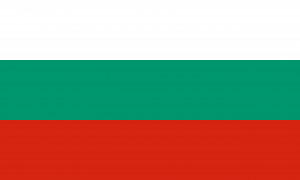Difference between revisions of "Language/Bulgarian/Pronunciation/Palatalization"
(→Note) |
m (Quick edit) |
||
| (5 intermediate revisions by 2 users not shown) | |||
| Line 1: | Line 1: | ||
[[File:Bulgarian-Language-PolyglotClub.png|thumb]] | [[File:Bulgarian-Language-PolyglotClub.png|thumb]] | ||
<div | <div class="pg_page_title"> Palatalization in Bulgarian</div> | ||
Palatalization. Most consonants in Bulgarian occur in both palatalized and non-palatalized varieties. | Palatalization. Most consonants in Bulgarian occur in both palatalized and non-palatalized varieties. | ||
<span link>With the completion of this lesson, consider investigating these related pages:</span> [[Language/Bulgarian/Pronunciation/Alphabet-and-Pronunciation|Alphabet and Pronunciation]], [[Language/Bulgarian/Vocabulary/Count-from-1-to-10|How to count to 10 in Bulgarian (with audio)]] & [[Language/Bulgarian/Pronunciation/Voicing|Voicing]]. | |||
==What is Palatalization?== | ==What is Palatalization?== | ||
A palatalized consonant is one produced at the same primary point of articulation and with the same manner of articulation as its non-palatalized counterpart, but is given a secondary point of articulation by raising the tongue toward the palate as one does when pronouncing the y-glide й. | A palatalized consonant is one produced at the same primary point of articulation and with the same manner of articulation as its non-palatalized counterpart, but is given a secondary point of articulation by raising the tongue toward the palate as one does when pronouncing the y-glide й. | ||
| Line 14: | Line 15: | ||
Already being palatal in primary point of articulation, the consonants ч, дж, ш, ж and й are not subject in Bulgarian to the palatalized – non-palatalized distinction. | Already being palatal in primary point of articulation, the consonants ч, дж, ш, ж and й are not subject in Bulgarian to the palatalized – non-palatalized distinction. | ||
Palatalized consonants occur only before non-front vowels in contemporary Bulgarian (where non-palatalized consonants also may occur). | Palatalized consonants occur only before non-front vowels in contemporary Bulgarian (where non-palatalized consonants also may occur). | ||
==History== | ==History== | ||
During the course of the history of the language any palatalized consonants that once were found before front vowels, before other consonants or in word-final position underwent a hardening (i.e. a loss of palatalization). | During the course of the history of the language any palatalized consonants that once were found before front vowels, before other consonants or in word-final position underwent a hardening (i.e. a loss of palatalization). | ||
==Examples== | |||
== | |||
Note, for example, the distribution of [л] and [л’] in the following words: | Note, for example, the distribution of [л] and [л’] in the following words: | ||
*учител [учитил] ‘teacher’, | *учител [учитил] ‘teacher’, | ||
| Line 28: | Line 27: | ||
*учители [учитили] ‘teachers’ and учителка [учитилкъ] ‘teacher (feminine)’; | *учители [учитили] ‘teachers’ and учителка [учитилкъ] ‘teacher (feminine)’; | ||
And of [н] and [н’] in the following words: | |||
*син [син] ‘blue (masculine singular) ’, | *син [син] ‘blue (masculine singular) ’, | ||
*синя [син’ъ] ‘blue (feminine singular)’, | *синя [син’ъ] ‘blue (feminine singular)’, | ||
| Line 36: | Line 35: | ||
==Sources== | ==Sources== | ||
http://www.seelrc.org:8080/grammar/pdf/stand_alone_bulgarian.pdf | http://www.seelrc.org:8080/grammar/pdf/stand_alone_bulgarian.pdf | ||
==Other Lessons== | |||
* [[Language/Bulgarian/Pronunciation/Affricates|Affricates]] | |||
* [[Language/Bulgarian/Pronunciation/Voicing|Voicing]] | |||
* [[Language/Bulgarian/Pronunciation/Alphabet-and-Pronunciation|Alphabet and Pronunciation]] | |||
<span links></span> | |||
Latest revision as of 13:12, 27 March 2023
Palatalization. Most consonants in Bulgarian occur in both palatalized and non-palatalized varieties.
With the completion of this lesson, consider investigating these related pages: Alphabet and Pronunciation, How to count to 10 in Bulgarian (with audio) & Voicing.
What is Palatalization?[edit | edit source]
A palatalized consonant is one produced at the same primary point of articulation and with the same manner of articulation as its non-palatalized counterpart, but is given a secondary point of articulation by raising the tongue toward the palate as one does when pronouncing the y-glide й.
This produces an effect on the sound quality that is sometimes described as “softening”, and palatalized consonants are sometimes referred to as “soft consonants”.
Thus [д’] is a stop formed through closure at the dental point of articulation, but has a softened quality due to the palatalization created by raising the tongue toward the palate.
Already being palatal in primary point of articulation, the consonants ч, дж, ш, ж and й are not subject in Bulgarian to the palatalized – non-palatalized distinction.
Palatalized consonants occur only before non-front vowels in contemporary Bulgarian (where non-palatalized consonants also may occur).
History[edit | edit source]
During the course of the history of the language any palatalized consonants that once were found before front vowels, before other consonants or in word-final position underwent a hardening (i.e. a loss of palatalization).
Examples[edit | edit source]
Note, for example, the distribution of [л] and [л’] in the following words:
- учител [учитил] ‘teacher’,
- учителят [учитил’ът] ‘the teacher’,
- учителю [учитил’у] ‘teacher (vocative)’,
- учители [учитили] ‘teachers’ and учителка [учитилкъ] ‘teacher (feminine)’;
And of [н] and [н’] in the following words:
- син [син] ‘blue (masculine singular) ’,
- синя [син’ъ] ‘blue (feminine singular)’,
- синьо [син’у] ‘blue (neuter singular)’,
- сини [сини] ‘blue (plural)’ and синкав [синкъф] ‘bluish (masculine singular)’.
Sources[edit | edit source]
http://www.seelrc.org:8080/grammar/pdf/stand_alone_bulgarian.pdf
Other Lessons[edit | edit source]
